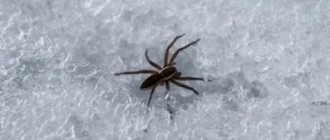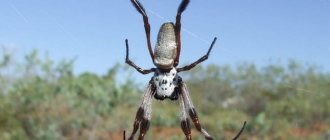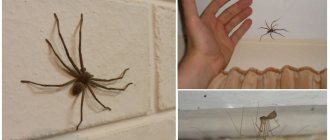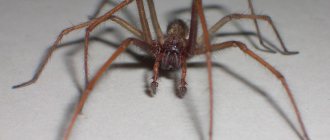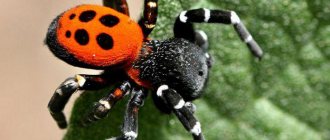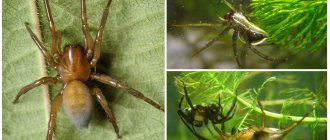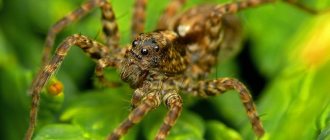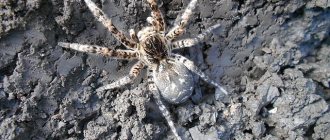The most dangerous and poisonous spiders in Russia
Almost all spiders are predators. There is only one species that prefers plant foods. Other arachnids hunt other living creatures for food.
Most of them have poisonous glands attached to their fangs. Almost all spiders are poisonous.
Another thing is that the poison of most species is slightly toxic and not dangerous to humans. And the small fangs of some arthropods are not able to bite through the integument of the human body.
That is why, of all the variety of species inhabiting Russia, it is important to know which spiders can pose a danger to humans. Let's look at which spider is the most poisonous in Russia.
Karakurt or black widow
First, let's look at which spiders in Russia are the most poisonous. Scientists believe that these are karakurts, which are also sometimes called black widows. A karakurt bite can lead to human death.
Its poison is especially dangerous for the elderly and children. It lives in areas with a relatively warm climate, although in the summer it may migrate north. Often found in the Black Sea regions, the Southern Urals, and the Caucasus.
Females are considered the most dangerous to humans. Firstly, they are much larger than males: they can reach a size of up to 2 cm. Secondly, they are more aggressive, and therefore attack people more often.
Karakurt has a bright color, which is intended to indicate its toxicity. Predators, seeing bright scarlet spots on the abdomen, prefer to avoid the arthropod. From below on the animal’s abdomen you can see an orange spot, similar to an hourglass.
Mizgir or South Russian tarantula
Poisonous spiders in Russia are represented by another common species. The South Russian tarantula or wolf spider is found in the southern regions of Russia.
It lives in deserts, semi-deserts and steppes . Females reach 4 cm in length and are significantly larger than males. Color varies from brown to reddish.
This species does not spin webs. He digs deep holes. The mizgir will attack the victim from an ambush - it jumps out of the hole and digs in with its fangs. Not a single death caused by a Mizgir bite has been recorded.
However, the venom of the arthropod has a fairly high toxicity. The area that was bitten becomes very swollen and red. The person is in severe pain. More serious consequences are possible due to an allergic reaction to the poison.
Cheiracanthium phalanx
Included in the list of the most dangerous spiders in Russia. It is considered the most poisonous in the middle zone. Its bite can be fatal only if a person has an allergic reaction to the venom of this species. The victim will experience severe pain, high fever, nausea, redness and swelling of the affected area.
The size of the arthropod reaches 50-100 mm. It has a light beige or yellowish color. Likes to hide in tree branches and under foliage.
It can attack a person in self-defense. More active at night when he goes hunting. Heiracanthum is attracted to the smell of gasoline, so it can be found near oil refineries.
Web spider
In Russia there are web spiders, which are also often called cross spiders. The arthropod can be distinguished by four light spots on the abdomen, which form a kind of “cross”. Females reach 2.5 cm, males grow up to 1 cm. The networm weaves a round web, along which it moves very quickly.
Not the most dangerous species for humans . Most often, the small fangs of an arthropod are not able to bite through human skin.
And if this does happen, a person can only feel pain. The bite site may become red and slightly swollen. The species is not aggressive and can attack only in self-defense.
Pouch spider or bagworm
The bagworm is also often included in the list of dangerous spiders in Russia. It can be found in the Rostov and Volgograd regions. Loves warm, dry climates and is able to migrate north in summer. The length of the paw span reaches 2 cm. It has a light color. There are two long light yellow stripes on the abdomen.
The bagworm is not very toxic, but it is very aggressive. Particularly dangerous are females who protect their cocoon. The arthropod runs very fast and jumps quite high.
In the event of a bite, a person’s body temperature rises, nausea and severe pain appear not only in the area of the bite, but also in large areas of the body. Sometimes a bite can lead to tissue necrosis.
Black fathead
The most poisonous spiders in Russia include another species - the black fathead. Females reach 2 cm in paw span. The main distinguishing feature is the bright scarlet belly, on which there are four black dots.
Distributed in the Urals and Central Russia . Settles in deep holes or under stones. The spider runs fast. If danger arises, it bites without hesitation. People who want to take a bright handsome man in their arms often suffer.
The venom of the black fathead is not very toxic. The person feels acute pain at the time of the bite. Afterwards, the bite site begins to go numb. For several days after this, the limb may have difficulty working. The affected area hurts when pressed.
Argiope spider
Argiopes are spiders in central Russia. They are also often called wasp spiders. They can be found along roads, on bushes and leaves of plants, and meadows.
Females can grow more than 3 cm in leg span. The body is light. The yellow belly is crossed by thin black stripes. Most active at night. Hunts using nets.
Argiope poison is not very dangerous. It is the females that are dangerous to humans due to their large size. The bite itself is quite painful due to the large chelicerae of the spider. The affected area becomes numb and swells a little. Full recovery occurs in three days.
Tarantula spider – Theraphosidae
The tarantula spider is perhaps the largest spider in the world, or rather the family of tarantula spiders (Theraphosidae). Some members of this family can reach 30.5 cm in leg span, such as the king baboon, black tarantula and purple tarantula. The body of tarantulas is always densely covered with long and short hairs. Body color can be either gray-brown or bright colors (red, blue, red). Tarantulas live in countries with hot climates (Africa, South America, Oceania, Australia). These spiders inhabit abandoned nests of birds and rodents or dig holes near tree trunks. They are active mainly in the evening. Then they go hunting or catch a prey running nearby. Tarantulas feed on insects, small birds and rodents. These spiders breed in late summer. The female lays eggs in a cobweb cocoon, which she carries with her and does not lose sight of. They protect the offspring, so that the spiderlings that emerge from the cocoon sit on the mother’s abdomen for some time. But soon they begin to lead an independent life. The tarantula's venom paralyzes the victim and decomposes its entrails, then the spider sucks out the contents of the victim's body. For humans, the tarantula's venom is not dangerous, but quite painful. The bite site bakes, hurts and swells, sometimes turning yellow. But these symptoms go away after a few weeks.
Widespread species of spiders in Russia
Poisonous spiders make up only a small part of the total species diversity in Russia. Non-poisonous species are ubiquitous and pose no danger to humans.
Moreover, they are orderlies who destroy other insects that are more dangerous to people. Next we will tell you about other types of spiders in Russia.
But first it is worth noting that the largest spider in Russia is the South Russian tarantula, which we have already reviewed. But we will describe other popular inhabitants of our area below.
Horses
Another name is jumping spider. Distributed everywhere. He can often be found basking in the sun. Males and females reach a size of 5-6 mm. There are 4 pairs of eyes on the cephalothorax: 2 of which are very large and mobile. The arthropod's vision is very good. It allows you to estimate the distance to prey.
A very jumping animal, it can jump up to 20 cm vertically. This happens due to the build-up of pressure inside the limbs.
Does not weave cobwebs. It attacks the victim from an ambush. Before jumping, the horse attaches itself to the surface with a thread of web so as not to be damaged as a result of a fall.
The horse is poisonous, but very small. Its fangs are not capable of cutting through human skin. In addition, this species is not aggressive.
Hunters
Hunters or dolomedes are spiders of central Russia. They prefer high humidity, and therefore settle on the banks of reservoirs, near swamps and in wet meadows.
Females reach 2.2 cm in length, males are twice as small. Body color is yellow-brown. Two parallel white stripes run along the cephalothorax and abdomen.
This species is able to move along the surface of the water and even dive. It does not dig holes, but settles in the greenery of coastal vegetation. The animal hunts not only insects, but also fish fry, which it drags onto land for a meal. The hunter is not dangerous to people.
Funnel
Funnel-web spiders are quite common in Russia. Another name for them is house spiders. The body is beige-brown in color. There are two thin dark stripes on the cephalothorax and abdomen.
The abdomen is elongated. The front pair of walking legs is much longer than the others. The arthropod weaves a funnel-shaped web. It can be sticky or non-sticky.
The spider is quite aggressive, but almost not dangerous to people . Its poison is not so toxic as to cause significant harm to the human body. However, cases of necrosis have been reported.
Orb weavers
Several species of the orb weaver family are common in the Russian Federation. These include the crosses that we talked about earlier. This family is famous for its ability to spin large webs.
Appearance may vary depending on the species. They are united by the presence of a spinous process on the last pair of legs. It is needed for weaving webs. Orb weavers are also found in northern Russia. They live wherever they can get food.
Synanthropic species
Synanthropic spiders live in Russia - these are species that choose human dwellings to live. They are often harmless to humans.
One of the most common is the centipede . She often lives between window frames or weaves webs in dark corners. It stands out for its long limbs relative to the body. Absolutely non-aggressive and too small to harm a person.
Window spiders often live under window sills. They reach 1 cm in size. The body is black, on which you can sometimes see a yellow pattern.
The black hobo spider is also often found indoors. He does not weave webs, he hunts from ambush. Stays in the dwelling as long as there is prey for it, and then leaves.
Safe types
It should be noted right away that absolutely all spiders are poisonous, but only a few will be dangerous to human health - arthropods with highly toxic poison. In this chapter we will look at those whose venom is lethal exclusively to insects.
House spiders
These are perhaps the most famous and most common spiders living in Russia. They got their name because they love to be neighbors with people - they can be found in a private house, in a city apartment, and in outbuildings. This spider usually weaves a funnel-shaped web in dark corners under the ceiling or in more secluded places, for example, somewhere behind a closet. The owner himself usually sits in the center of the fishing net and patiently waits for the prey to fall into it. And as soon as the victim is in the web, the spider runs up to her with lightning speed and immediately straightens out.
You can recognize a house spider by the following signs:
- the integument is yellowish-gray or brownish-gray;
- on the back there are usually brown spots arranged in a pattern;
- the legs are dark brown, their length is approximately twice as long as the body;
- The size of females is about 12 mm, the male is no more than 10 mm.
Knitting spiders
There are quite a few species of crocheters, and these spiders are found in Russia more often than others. They are distributed throughout the country and live exclusively in natural conditions. Their trapping nets are circular in shape and have very large meshes. Because of them, at first glance, it may seem that such a web is not suitable for hunting. However, it is not. The net is designed for a specific victim, namely long-legged mosquitoes, which are a favorite delicacy for knitters.
The knitting spider has the following description:
- elongated body;
- legs are long;
- chelicerae are covered with numerous projections;
- Females are usually about 10 mm in size, males are somewhat smaller.
This is interesting! When in danger, the knitting spider extends its legs along its body and becomes like a tiny straw. If you disturb him, he will immediately throw himself down like a stone and try to hide!
Spiders of central Russia
Arthropods live here, their habitat extending from Central Europe to Murmansk. The most common spiders in central Russia are Heiracanthium and Silverwort.
Heiracanthium is found in the Moscow region, Southern Siberia and the Volga region. This is a rather poisonous species that lives far from human habitations, and therefore cases of its bites are rare.
The silverfish is one of the few species of arachnids in which the size of the male exceeds the size of the female and can reach 1.5 cm. The spider settles in water bodies.
Its body is covered with a special secretion, which, when immersed under water, allows it to retain air on the animal’s body. Because of the air gap, the diving spider appears silver. The arthropod feeds on fish fry.
Thus, spiders quite easily adapt to any living conditions, and therefore they can be found everywhere throughout Russia.
The most dangerous species in Russia is the karakurt. Spider bites rarely cause death, but they are dangerous not only because of the toxicity of the venom, but also because of a possible allergic reaction. This is why a bite from even a harmless and non-toxic spider can have serious consequences.
Tarantula Spider Conservation
Photo: Tarantula spider from the Red Book
The South Russian tarantula, which has the second name Mizgir, is listed in the Red Book of the Republic of Tatarstan and classified as category 3 of species that are reducing their numbers; in the Red Book of Udmurtia, where it was assigned category 4 with an uncertain status; Red Data Book of the Nizhny Novgorod Region in category B3.
Limiting factors are active human agricultural activity, natural enemies, destruction of characteristic habitats, loss of dry grass, changes in groundwater levels, trampling of wet biotopes, military operations in semi-deserts, and an increase in plowed areas.
The species is protected by the Zhigulevsky Nature Reserve, the Prisursky Nature Reserve on the territory of the Batyrevsky site and the Samarskaya Luka National Park. Conservation measures include educational work among residents to limit the catching of arthropods. There are farms for breeding tarantulas in Mexico.
Conservation measures that need to be implemented include identifying the arachnid's natural habitats and providing the protection required for the species. The dry grass has stopped falling in the spring. Organization of NP "Zavolzhye". Restriction or cessation of economic activity, limitation of chemicals for spraying plants, suspension of livestock grazing.
The tarantula spider is not an aggressive animal. He will prefer to escape than attack a person. An attack can be provoked by the actions of people who touch the spider or get too close to the hole. Fortunately, the bite of a predator is comparable to a bee sting, and the blood of the spider itself can best neutralize the effect of the poison.
Tags:
- Entelegynae
- Lycosoidea
- Neocribellatae
- Opisthothelae
- Panarthropoda
- Araneomorph spiders
- Bilaterally symmetrical
- Animals of Australia
- Animals of Australia and Oceania
- Animals of Austria
- Animals of America
- Animals of Bolivia
- Animals of Brazil
- Animals of Greece
- Animals of Eurasia
- Animals of Western Siberia
- Animals of Iran
- Animals of Spain
- Animals of Italy
- Animals of the Caucasus
- Animals of the Red Book
- Animals of the Red Book of Russia
- Animals of Crimea
- Animals of the forest-steppe
- Meadow animals
- Animals of Mongolia
- Animals starting with the letter P
- Animals starting with the letter T
- Animals of the Nizhny Novgorod region
- Animals of the fields
- Semi-desert animals
- Animals of Portugal
- Desert Animals
- Animals of deserts and semi-deserts
- Animals of Russia
- Animals of Romania
- Animals of North America
- Animals of Siberia
- Animals of the steppe
- Animals of the Russian steppe
- Animals of the Subtropical Zone of the Northern Hemisphere
- Animals of the Subtropical Zone of the Southern Hemisphere
- Animals of Tatarstan
- Rainforest Animals
- Rainforest Animals
- Animals of the Tropical Zone of the Northern Hemisphere
- Animals of the Tropical Zone of the Southern Hemisphere
- Animals of Turkmenistan
- Animals of Ukraine
- Red Book of the Nizhny Novgorod Region
- Red Data Book of the Republic of Tatarstan
- Red Book of Tatarstan
- Red Book of Udmurtia
- Shedding
- Dangerous animals of Australia
- Dangerous animals of Russia
- Dangerous spiders
- Dangerous spiders in Russia
- Spiders
- Spiders of Russia
- Wolf spiders
- Protostomes
- Rare animals of Russia
- The most disgusting spiders
- The most dangerous animals in Russia
- The most dangerous spiders
- The most dangerous spiders in Russia
- The most terrible spiders
- The most poisonous spiders in Russia
- Scary spiders
- Tarantulas
- Cheliceraceae
- Arthropods
- Eukaryotes
- Eumetazoans
- Poisonous animals of Russia
- Poisonous spiders in Russia
- Poisonous spiders of Crimea


